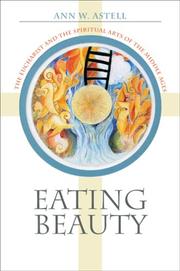| Listing 1 - 3 of 3 |
Sort by
|
Book
ISBN: 9781632961020 9781632961044 9781632961044 1632961024 1632961040 1632961040 Year: 2016 Publisher: Houston: Lucid Books,
Abstract | Keywords | Export | Availability | Bookmark
 Loading...
Loading...Choose an application
- Reference Manager
- EndNote
- RefWorks (Direct export to RefWorks)
Last Supper. --- Dinners and dining in the Bible. --- Lord's Supper.
Book
ISBN: 9781498282925 149828292X 1498282946 9781498282949 9781498282932 1498282938 Year: 2016 Publisher: Eugene, Oregon : Pickwick Publications,
Abstract | Keywords | Export | Availability | Bookmark
 Loading...
Loading...Choose an application
- Reference Manager
- EndNote
- RefWorks (Direct export to RefWorks)
Lord's Supper --- Church --- 265.3 <063> --- Communion --- Eucharist --- Holy Communion --- Sacrament of the Altar --- Blood --- Sacraments --- Sacred meals --- Last Supper --- Mass --- 265.3 <063> Eucharistie--Congressen --- Eucharistie--Congressen --- Ecclesiastical theology --- Ecclesiology --- Theology, Ecclesiastical --- People of God --- Theology --- Religious aspects --- Christianity --- Festschrift - Libri Amicorum --- Lord's Supper.

ISBN: 9780801444661 0801444667 1501704559 1501704540 Year: 2016 Publisher: Ithaca, NY : Cornell University Press,
Abstract | Keywords | Export | Availability | Bookmark
 Loading...
Loading...Choose an application
- Reference Manager
- EndNote
- RefWorks (Direct export to RefWorks)
"The enigmatic link between the natural and artistic beauty that is to be contemplated but not eaten, on the one hand, and the eucharistic beauty that is both seen (with the eyes of faith) and eaten, on the other, intrigues me and inspires this book. One cannot ask theo-aesthetic questions about the Eucharist without engaging fundamental questions about the relationship between beauty, art (broadly defined), and eating."-from Eating BeautyIn a remarkable book that is at once learned, startlingly original, and highly personal, Ann W. Astell explores the ambiguity of the phrase "eating beauty." The phrase evokes the destruction of beauty, the devouring mouth of the grave, the mouth of hell. To eat beauty is to destroy it. Yet in the case of the Eucharist the person of faith who eats the Host is transformed into beauty itself, literally incorporated into Christ. In this sense, Astell explains, the Eucharist was "productive of an entire 'way' of life, a virtuous life-form, an artwork, with Christ himself as the principal artist." The Eucharist established for the people of the Middle Ages distinctive schools of sanctity-Cistercian, Franciscan, Dominican, and Ignatian-whose members were united by the eucharistic sacrament that they received. Reading the lives of the saints not primarily as historical documents but as iconic expressions of original artworks fashioned by the eucharistic Christ, Astell puts the "faceless" Host in a dynamic relationship with these icons. With the advent of each new spirituality, the Christian idea of beauty expanded to include, first, the marred beauty of the saint and, finally, that of the church torn by division-an anti-aesthetic beauty embracing process, suffering, deformity, and disappearance, as well as the radiant lightness of the resurrected body. This astonishing work of intellectual and religious history is illustrated with telling artistic examples ranging from medieval manuscript illuminations to sculptures by Michelangelo and paintings by Salvador Dalí. Astell puts the lives of medieval saints in conversation with modern philosophers as disparate as Simone Weil and G. W. F. Hegel.
Art --- Christian dogmatics --- anno 500-1499 --- Lord's Supper --- Aesthetics --- Food --- Spiritual life --- Eucharistie --- Esthétique --- Aliments --- Vie spirituelle --- Catholic Church --- History of doctrines --- Religious aspects --- Catholic Church. --- Eglise catholique --- Histoire des doctrines --- Aspect religieux --- -Lord's Supper --- -Aesthetics --- -Food --- -Spiritual life --- -265.3 --- Life, Spiritual --- Religious life --- Spirituality --- Foods --- Dinners and dining --- Home economics --- Table --- Cooking --- Diet --- Dietaries --- Gastronomy --- Nutrition --- Beautiful, The --- Beauty --- Esthetics --- Taste (Aesthetics) --- Philosophy --- Criticism --- Literature --- Proportion --- Symmetry --- Communion --- Eucharist --- Holy Communion --- Sacrament of the Altar --- Blood --- Sacraments --- Sacred meals --- Last Supper --- Mass --- -History of doctrines --- -Catholic Church --- -Religious aspects --- -Eucharistie --- Psychology --- Christianity --- 265.3 Eucharistie --- Esthétique --- 265.3 --- Religious aspects&delete& --- Radio broadcasting Aesthetics
| Listing 1 - 3 of 3 |
Sort by
|

 Search
Search Feedback
Feedback About
About Help
Help News
News